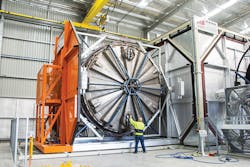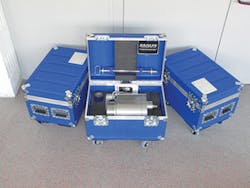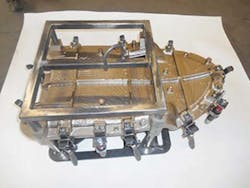Toolmakers target rotomolders for cooling, mold improvements
The rotational molding industry is seeing strong efforts from mold makers looking to gain greater control over mold and part temperature during a process that has been resistent to temperature management. Their developments have affected the nature of mold cooling and heating as well as demolding, or part removal. One expert says such mold-based work amounts to "future-proofing" for the rotomolding industry.
Internal mold cooling shows promise
Rotational molding, known for its ability to make large, bulky products (think children's outdoor play toys, kayaks, and water and septic tanks, for example) competes well in design and overall dimensional versatility, says Mark Kearns of Queen's University, Belfast, Northern Ireland. But it lags in other key areas such as production; equipment and tooling; dimensional stability; material selection; ease of material and part handling; and energy efficiency and cycle times.
One limiting factor for that is, generally, the rotational mold is cooled only from the outside, a typically fast and uncontrolled cooling process. So the inaccessible, inside of the plastic part, which cools slowly, has a tendency to be more crystalline, with a different and higher density than the outside, which leads to warpage — and scrap.
Kearns, molding manager in the Mechanical and Manufacturing Engineering department at Queen's University, is a progressive thinker when it comes to the rotational molding process. One technology to come out of his research has resulted in a device dubbed the Rotocooler, which has been further developed commercially by rotational mold maker Maus GmbH Modell- und Formenbau, Karlsruhe, Germany.
Forced air is typically used for external cooling. But the Rotocooler device uses an internal mold water spray that cools the mold as the water quickly evaporates, achieving a symmetrical, uniform cooling both inside and outside to produce a much more homogenous, crystalline structure across the thickness of a part. The Rotocooler is mounted to the mold frame and activated by compressed air.
Kearns undertook a three-year study, "Factors affecting internal water cooling," with HDPE, MDPE, and PP, that documented the advantages of using internal mold water spray cooling to improve product quality and increase production.
Rory Jones, owner of La Plastecnica Ltd. of Christchurch, New Zealand, also promotes internal water cooling in rotomolding as a more efficient and faster way to cool the mold, to decrease cycle times and eliminate warpage. Plastecnica's unit is called Supacool. It bolts onto the outside of vent holes, connects to a compressed air line and an injector delivers up to 3 liters of fine water mist inside the part during cooling.
In North America, Norstar Aluminum Molds Inc., Cedarburg, Wis., distributes both the Rotocooler and the Supacool.
Kearns' R&D at Queens University focuses on innovations that can make a competitive difference to rotational molders. Kearns says his three-year trial shows that the Rotocooler's cooling technique increases efficiency by optimizing machine usage and maximizing throughput. It lowers production costs by cutting cycle times; improves part quality with more accurate dimensional properties and tolerances and less warpage and shrinkage; and reduces energy consumption as less energy is required to cool products down.
Also, Kearns says, the use of skin/foam/skin composite structures in rotomolding is becoming more common in certain sectors, particularly underground storage tanks and marine applications. The cycle times associated with these types of structures are notoriously long, he says, and the use of the Rotocooler can significantly lower production times of these high-value-added products, making it more cost effective to produce them.
Suppliers target mold structure,
handling techniques
Persico SpA, the Nembro, Italy-based maker of the Leonardo rotomolding machine, has introduced a new CNC aluminum mold design that aims to increase exposure to heating and cooling via a new, lighter mold shell and framing structure. Besides adding unnecessary weight to the mold, the frame also absorbs quite a lot of energy during the molding process, making it less efficient.
Sergio Zilioli, head of Persico's North American sales, says the design incorporates clamps to be installed directly on flanges. By integrating ribs into the mold shells, the clamp pressure generated is equally distributed along the mold flanges. The technology significantly reduces mold weight and enhances heat exchange — hence the name of the product, "light molds," as the new design results in a lighter mold with better performance, Zilioli says.
At Rotoplas last fall, Persico showed a CNC light mold for a child's sled. Also at that event, Persico featured a mold treatment for increasing the hardness and strength of the mold that results in drastically reduced maintenance and demolding times, Zilioli says. A conventional Teflon coating can be easily damaged or removed from the mold surface, he says. Persico's new P650 treatment is a hardening and coating combination that can convert a mold having a hardness of 80HV to one with a hardness of around 550 HV, he says.
Michel Truax, sales director of STP Rotomachinery, Sherbrook, Quebec, says that company has designed a "techno plate system" that supports the mold and allows side-to-side movement. The STP system is designed for rotomolders running large molds that need to have the top of the mold clear of obstructions for ease of operation.
Normally STP recommends using an arm closure to support the other end of the mold, but that is not always efficient, the company says. That dilemma spurred development of the techno-plate system. On the SRM Series three-sided shuttle machine, for example, the regular plate (minor axis) is replaced by a universal joint that will allow movement and not break off. The mold can move sideways and is supported by spring-loaded steel wheels on the techno-plate steel frame. The top of the mold, where the lid is normally placed, is always free, making it easier to remove parts with an overhead crane, an advantage for molders handling very heavy loads.
Being able to produce rotational molds rapidly and with precision gives rotomolders the significant advantage of accelerated manufacturing lead times, said Tom Innis, VP of sales and marketing for cast and CNC aluminum tooling producer Avantech, Brainerd, Minn., who spoke during Rotoplas, held Oct. 6-9 in Rosemont, Ill.
Avantech has made significant investments in CNC machinery, Innis said. The company currently operates 11 CNC machining centers for tool and pattern production. Innis said such investments in toolmaking technology are essential to improving the rotational molding process.
Merle R. Snyder, senior correspondent



